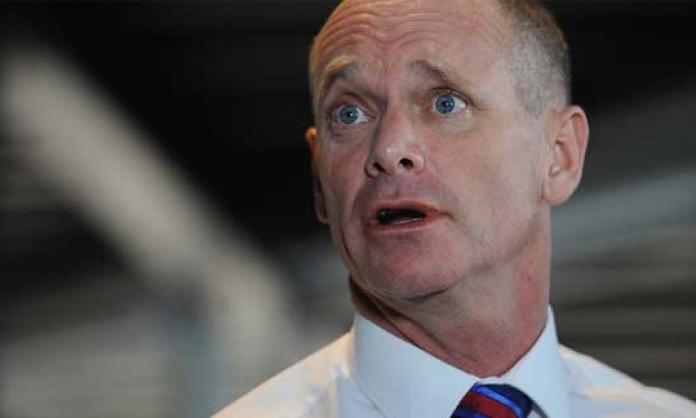The Newman government was smashed on Saturday night. From an apparently unassailable position, holding three quarters of the seats in a single-chamber parliament, the Liberal National Party felt the full force of the backlash from the Queensland working class. It now seems likely that the ALP will be back in office.
This election was a referendum on the neoliberal agenda of budget cuts, privatisation and mass public and community sector sackings and closures. The result was a resounding rejection of this agenda.
The LNP went into the election proposing to fund a range of new infrastructure projects – roads, hospitals, schools and public transport – out of the $37 billion that it planned to raise by leasing ports, power stations, water pipelines and electricity networks. The electoral drubbing demonstrated that people wanted to keep vital infrastructure in public hands.
Newman in office
The Newman government came to office in 2012 with a massive swing. People turned out in droves to register their opposition to the Bligh government’s privatisation program.
But despite the ALP being reduced to just seven seats in the 89-seat chamber, the LNP never won much public affection. People were right to be sceptical. Within three months, Newman unveiled a program of mass sackings in the public sector and the defunding of dozens of community programs. By the end of the year, 14,000 public sector workers had been sacked along with several thousand more in the community sector, as their organisations shut down or cut staff.
The impact was devastating, both in Brisbane and in the regional areas. In 2013, state GDP actually fell. Newman promised in the 2012 election campaign to reduce unemployment to 4 percent; it has actually risen to 6.6 percent. Youth unemployment in some regional centres and working class Brisbane suburbs has hit 25 percent. Since April 2012, the number of unemployed has risen by 31,000 and any job growth that has occurred has been in part time jobs – the number of full time workers has fallen by 8,000.
Although the rise in unemployment in the past 12 months has been put down to the mining bust, joblessness has risen almost across the board. Meanwhile 27 TAFEs have been shut, replaced by shonky private operators, denying many young people decent training opportunities.
Those who kept their jobs in the public sector had their wages cut and their rights at work trashed. The Newman government mounted a sustained campaign against trade unions, introducing new laws to restrict their operations.
Ruling for the rich
While crying wolf about a supposed debt crisis, the Newman government nonetheless ensured that its rich backers filled their pockets. In 2014, the government offered the Adani mining company hundreds of millions of dollars to build a railway line from the Galilee basin in Central Queensland to the company’s Abbot Point coal loading terminal.
It also gave more than $110 million to the Gold Coast racing industry and $300,000 in legal support to the mining companies’ challenge to the Gillard government’s mining tax.
All the corruption associated with the Joh Bjelke Petersen government, which ran Queensland for 21 years until being booted out in 1989, came flooding back. Sand mining company Sibelco bankrolled Newman’s 2012 election campaign, in return for which Newman reversed the Labor government’s decision to end sand mining on Stradbroke Island and, instead, extended the company’s licence to 2035.
Restrictions on land clearing were lifted and the government also weakened regulation of the coal seam gas industry.
Civil liberties went under the hammer as well, most notoriously with the anti-bikie laws – the Vicious Lawless Associations Disestablishment (VLAD) legislation – which suspended habeas corpus and freedom of association rights for anyone deemed by the attorney general to be a member or associate of a declared criminal organisation.
Aboriginal people also suffered under the Newman government. Money was ripped out of funding for Aboriginal groups, and the Tent Embassy in Musgrave Park in Brisbane was broken up in a raid by more than 200 police in May 2012.
Newman’s threats during the election campaign to remove funding from any electorates that voted against the LNP were just the latest example of the bullying for which his government became notorious. Even rusted-on Liberal supporters in the medical and legal professions expressed their opposition to being railroaded and slandered by Newman and his ministers – Newman, for example, accused lawyers representing bikies of being part of a “criminal gang machine”. Doctors in the public health system protesting against the imposition of new government contracts were threatened with replacement by overseas specialists.
Symptomatic of the disquiet in these circles were comments by Tony Fitzgerald, author of the report that brought down the Bjelke Petersen government, that the Newman government had “set a new low standard” in integrity and fairness.
This result, on top of the Liberal defeat in Victoria in November, will only add to the crisis currently coursing through the federal party. Although LNP strategists kept Tony Abbott out of the state for the duration of the campaign, this could not prevent voters from taking out their hostility to Abbott on the LNP’s local representatives.
Labor and the unions
After its disastrous showing in the 2012 election, the ALP is now back with a vengeance, winning at least 43 seats.
Labor’s campaign focused on opposing asset sales and made the point that privatisation would strip out jobs and services to the public. Labor also promised a modest increase in teachers and nurses and deferred payroll tax concessions to businesses, causing the bosses’ groups to squeal about lost jobs.
As with Newman’s victory in 2012, the ALP’s success is more the product of hostility towards the incumbent government than any fondness for the opposition. Its record on privatisation is still fresh in the public mind. Many voters can see that the two parties have far more in common with each other than they have with the working class.
Nevertheless, Labor’s campaign was dependent on the trade unions. Like Victorian ALP leader Daniel Andrews on his victorious election night, Queensland ALP leader Annastacia Palaszczuk made a point of praising the trade union movement. Even if they did not campaign for a Labor vote, the union call for LNP opponents to “Put the LNP last and number every box” amounted to the same thing. And even if the unions did not mobilise thousands of public sector unionists to knock on doors and letterbox, as they did in Victorian, trade unionists were the foot soldiers of Labor’s campaign.
Whether or not their loyalty will be rewarded remains to be seen.
The future
Queensland has now had two successive state elections with massive, record-breaking swings against the incumbents.
The common theme is privatisation which has been put to the electorate twice now and been roundly rejected each time.
There is a yawning gap between the policies to which both Labor and the LNP have been committed while in government, and the continued public attachment to the basics of public industry, a welfare state, award protections for workers and secure jobs. Despite 30 years of retreat by the workers’ movement, the ruling class has still not succeeded in getting the working class to abandon its attachment to these fundamental rights and conditions.
Whether it was Hewson in 1993, Kennett in 1999, Howard in 2007 or Newman today, every politician who presents a hard right wing economic agenda – attacking trade unions, wages and social welfare – has been defeated. It is this sentiment that also underpins the problems faced by the Abbott government, whose attacks on Medicare, pensions and higher education are widely unpopular.









